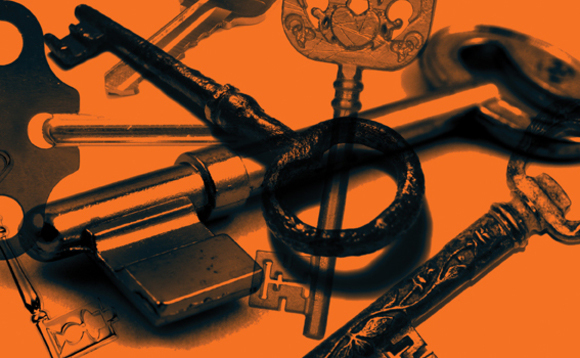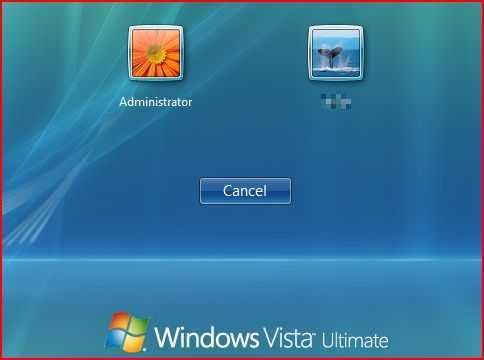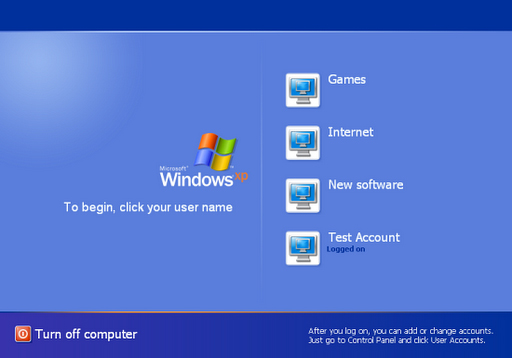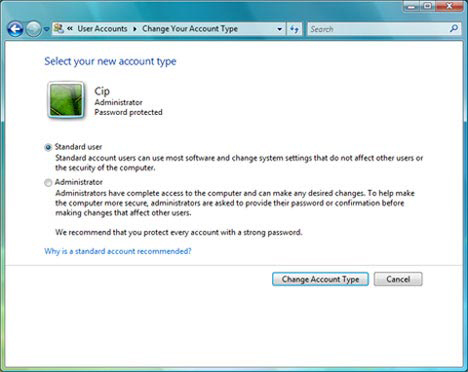Instructions for configuring computers for multiple users
QuanTriMang - User accounts are a great way to share a computer. Each user who owns an account can fully customize the way Windows works for their account along with the Desktop interface.
They can keep their favorite websites online and save them to a folder in My Documents that others cannot open. User accounts also allow owners to implement management methods of what others can do with the computer, by preventing them from installing new software or adding hardware devices.

In this article, we will look at how user accounts work in Windows XP, Vista and 7 and how to best utilize it.
Introducing user accounts
Windows does the job by creating a user account called Administrator or Owner . If you are the only person using the computer, this account is enough for you to use: use your account to access Windows, install and run software, surf the web, send email, edit data, . .
Of course, you don't even realize you're using such an account. However, the advantage of using an Administrator account becomes clearer when someone wants to share a computer - and a copy of Windows on it.
Users with Administrator accounts can create new user accounts or change the settings of the current account.
In addition to Administrator account, there are 2 other types of user accounts you should know: Standard (XP called Limited ) and Guest .
Standard accounts are designed for everyday use (for example, to share computers with other family members), while Guest accounts are designed for people who only want to borrow computers for a short period of time. (to check email for example).
Personalize the Administrator account
We will start by renaming and representing the Administrator account. We will also create a password for it so that unauthorized users cannot login.
Click Start , then Control Panel . Windows XP users will click the User Accounts → User Accounts link (or just double-click it if in Classic View ); Windows Vista and 7 users will click the Add or remove user accounts link under User Accounts and Family Safety heading .
If this is the first time you access the User Accounts management area, there will be only 2 entries displayed: Administrator and Guest . If necessary, click the Administrator account icon.
The next window provides more options, including the ability to rename the account, create a password (or change your existing password) or select a new avatar. Click on the account name option (the descriptive word will vary between versions of Windows). Next, on the next screen, fill in a name and click the Change Name button.
Next, if you haven't used a password yet, create it by clicking on the link then typing in the password, repeating it to confirm the spelling and accents. Click Create Password .
Finally, click on the option to change your avatar and choose one of the images available there or click Browse for more pictures and choose one of the photos in the computer hard drive. Then, click Change Picture when done and then close the open windows.

Create and use Standard account
Open the User Accounts dialog box described above. However, this time click on the link to create a new account (again, it must be mentioned that the description description will be different for each version of the Windows operating system). Enter a name for the new account, click Next and then select the Radio Limited (XP) or Standard user (Vista / 7) button and click Create Account .
Once you have created an account, it is now ready to personalize just like you did with the Administrator account in the above section by changing the avatar and creating a password protection.
So what happens if Windows starts? At this point, you will have an Administrator account with a Standard / Limited account. Click the Start button then select Log Off - XP and Windows 7 has a separate button for this option on the Start menu, while Windows Vista users need to click the pointing arrow to the right and select Shut Down .
In Windows XP, in the next dialog box, select Switch User and click on the newly created account name. Vista and Windows 7 users will be directed to the login screen: click on the account you need and enter the password needed to login.

After a few seconds, Windows will start working. You will see the icon on the Desktop returned to default, along with background Desktop. If this is the first time this account is used, you will see a lot of welcome messages using Windows.
Standard account users will have their own Documents, Music, Videos and Pictures folders.
Types of user accounts
Users need to understand the differences between different types of accounts, as well as the limitations associated with them. Users with Administrator accounts can perform or view anything on the computer, from viewing files and folders of other users to the ability to delete user accounts.
Those who log into Standard (Vista / 7) or Limited (XP) accounts can view other users' folders, but they cannot open them or view any files, even though the files are stored in folders. Shared or Public .
Such types of user accounts cannot also make changes that may affect other users, such as changing the security settings for Windows or installing (removing) the software.
Guest account is for temporary users. They do not require a password and are restricted from accessing the computer. Guest accounts can run software and surf the web.
In Windows XP and Vista, when a user logs off from the Guest account, all information, including the data they have just created, will be deleted. Windows 7 retains such data.

Safe use
There are many things to discuss about user accounts, but what we provide above is enough for you to use. However, if you share a computer with others, we recommend that users set a password to protect their account for each user to keep their data safe. Along with that, you, in the role of Administrator, will have to pay attention to regularly monitor the activities that occur on the computer.
You should read it
- How to login to multiple accounts on Telegram Messenger
- Use multiple Dropbox accounts on the same computer
- Additional instructions and use of multiple accounts on MS Office 2013
- How to log in to multiple WhatsApp accounts
- How to add account on Coc Coc browser
- Instructions for logging into multiple accounts on Google Chrome
- 4 ways to switch user accounts on Windows 11
- How to limit the time to use Local accounts on Windows 10
May be interested
- 9 basics of Windows 8
 in this article, we will provide a list of top 9 issues that users encounter with windows 8, along with some explanations and solutions.
in this article, we will provide a list of top 9 issues that users encounter with windows 8, along with some explanations and solutions. - Cleans, fixes Web-based system
 online service filelab windows cleaner supports you to scan junk and malware on your system without needing to install additional software.
online service filelab windows cleaner supports you to scan junk and malware on your system without needing to install additional software. - Interesting secret right on Google's search engine
 well-known as a company that likes to tease users, google always hides secrets inside its services. recently, a secret has just been found in google's search engine, which seems to welcome the upcoming christmas and new year.
well-known as a company that likes to tease users, google always hides secrets inside its services. recently, a secret has just been found in google's search engine, which seems to welcome the upcoming christmas and new year. - Try using the new features of Windows 8
 you don't have to wait until next year to know what windows 8 provides. use the tips below to update the look and feel of this operating system.
you don't have to wait until next year to know what windows 8 provides. use the tips below to update the look and feel of this operating system. - Instructions against Spam
 there are a few simple tactics users can use to reduce spam.
there are a few simple tactics users can use to reduce spam. - 10 things to do when you first buy a Mac
 if you unpack a new mac for the first time, you need to do the next to adjust the settings according to your preferences, practice using finger gestures, backup ...
if you unpack a new mac for the first time, you need to do the next to adjust the settings according to your preferences, practice using finger gestures, backup ...






 Instructions for configuring LDPlayer for each game type
Instructions for configuring LDPlayer for each game type How to configure FPT optical fiber Gpon modem
How to configure FPT optical fiber Gpon modem Instructions for installing LAN with the system using multiple operating systems
Instructions for installing LAN with the system using multiple operating systems Instructions for installing GIT and configuring GIT on Windows 10
Instructions for installing GIT and configuring GIT on Windows 10 How to Configure Users and Groups in OS X Mavericks Server App 3.X
How to Configure Users and Groups in OS X Mavericks Server App 3.X